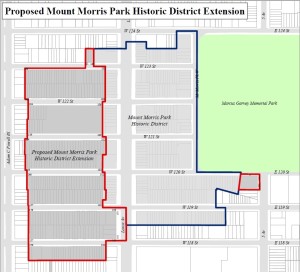
The proposed extension of the Mount Morris Park Historic District, outlined in red. Image credit: NYC LPC
276-property proposed extension shares developments history, scale and architecture with existing historic district. On July 21, 2015, the Landmarks Preservation Commission held a hearing on a possible extension to the 1971-designated Mount Morris Park Historic District . The extension is composed of 276 properties and lies east of Lenox Avenue, between 117th and 124th Streets. The extension shares its development history with the existing historic district as one of the first residential areas in Harlem, with most buildings constructed following the extension of rapid transit to the area around 1880.
The district is primarily characterized by rowhouses built in the late 19th and early 20th centuries for prosperous middle-class residents in a variety of styles including Queen Anne, Romanesque Revival and Second Empire. The extension would also include 12 apartment buildings, including a Beaux Arts-style building. In the 1920s, the area began attracting a significant African American population, and grew to become an important part of Harlem’s African American culture. Landmarks calendared the extension in April of 2015.
A representative of Congress Member Charles Rangel read a statement arguing that the extension’s designation was “behind time,” and marks the “culmination of years of relentless efforts” by the community to preserve its “historic, cultural, and architectural legacy.” A representative of Manhattan Borough President Gale Brewer read a statement in support, and Manhattan Community Board 10 voted overwhelmingly to issue a resolution in favor of designation. Chair Meenakshi Srinivasan stated that Council Member Inez Dickens had also communicated her “strong support” for destination to Landmarks.
Gene Norman, a former Chair of Landmarks, said the original district designation was much less than what the community sought, and the neighborhood was “cut in half”. Norman said Landmarks vowed to revisit the area at the time of the designation, and the extension, which would protect “among the finest buildings of their kind,” was long overdue. Preservationist, and member of Save Harlem Now, Michael Henry Adams said “Harlem’s legacy vanishes daily,” and argued for the necessity to “equitably designate and protect landmarks in non-affluent communities of color.” Representatives of the Mount Morris Park Community Improvement Association stated that the designation was “essential for maintaining the overall character” of the neighborhood, in the face of a “commercial rush” on the community.
The Real Estate Board of New York’s Paimaan Lodhi endorsed designation, calling the proposal “a genuine extension” of the original historic district, but identified six properties that the organization should be excised from the district. Anne Troy of the Emmaus House urged community members to focus on preserving affordable housing as well as historic architecture. Property owners Christian Volkmann and Lynnette Widder said the process for designation lacked transparency, that their section of 123rd Street lacked architectural quality, and the designation should be limited to brownstone rowhouses. Widder added that zoning and property taxes applied pressure to property owners to “build big.”
Chair Srinivasan said that Landmarks would look into concerns raised by property owners, and noted that the commission does regularly approve new development in historic districts, especially on vacant lots. Srinivasan said she was pleased to see “overwhelming support” from the community, and scheduled a vote on designation for September 22, 2015.
LPC: Mount Morris Park Historic District Extension, Manhattan (LP-2571) (July 21, 2015).
By: Jesse Denno (Jesse is a full-time staff writer at the Center for NYC Law)

